Restriction in the High Side of the System Manifold Gauge Readings
A vacuum gauge is an invaluable resources for tracking downwardly engine bug.
The cardinal is understanding what your gauge is trying to tell y'all. Nosotros've put together this quick-guide to reading your vacuum gauge to assistance you identify potential mechanical or tuning issues more quickly. Nosotros've seen this topic covered before, but it'south data worth repeating, keeping—and even bookmarking.
To get started you'll need to hook your vacuum approximate to an intake manifold vacuum source. You can claw a tee-fitting into an existing vacuum source or pull a line, such every bit 1 that leads to your transmission. Bank check to make sure all vacuum hoses are connected and non leaking.
Once y'all're engine is upwards to operating temperature, you can begin reading your vacuum approximate. Beneath are some of the most common readings and diagnoses you'll find:
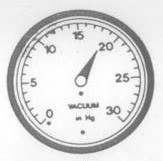
Normal
This a normal reading—between 17 and 22 inches of mercury. Proceed in mind, this reading is ideal for stock-cammed engines running at ocean level. Higher elevations may cause slightly lower readings. For every ane,000 anxiety above sea level, y'all can wait the reading to be about one inch lower. You lot can as well wait the readings to be lower for more aggressive cams.
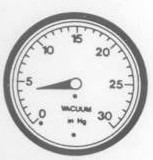
Steady Low/Extremely Low
The gauge at left shows an extremely low reading, which holds fairly steady. This means the engine is producing less power and, therefore, less vacuum. Common causes of steady low reading are blowby due to worn piston rings or possibly late ignition or valve timing. An extremely low reading could also indicate an air leak at the intake manifold or throttle body.
Steady Low/High Swing
A regular swing between high and low readings often means a diddled head gasket between two, side-by-side cylinders. To confirm, yous'll need to perform a compression examination.
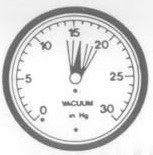
Rapid Vibration at Idle
If the needle vibrates rapidly between fourteen and 20 inches of mercury, simply then steadies equally rpm increases, you may exist dealing with worn valve guides. How fast the needle vibrates is telling of how many valve guides may be worn.
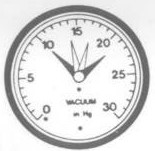
Fluctuation Under Acceleration
Conversely, if the estimate's needle swings back and forth as the engine accelerates, your valve springs are probably also week for your engine. The swing on the gauge is ordinarily anywhere from x to 22 inches of mercury, depending on the speed of the engine.
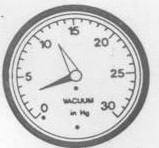
Desperate Needle Drib
With exhaust brake, the vacuum gauge volition often kickoff in the normal range simply will soon drop drastically as rpm is increased. You likely have a restriction somewhere within your exhaust system or a impairment frazzle component.
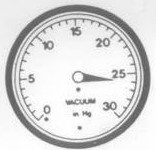
Abnormally High Reading
Conversely, a choked or restricted air cleaner would outcome in a higher than normal reading, depending on how difficult the engine works to pull in air.
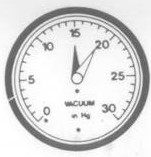
Normal/Depression Pattern
When the needle drops to a low reading, returns to normal, and and so repeats the pattern at regular intervals, you're probable looking at a burnt, sticking, or leaking valve. Often, a sticking valve will cause more desultory drops during this pattern.
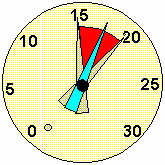
(image from pakwheels.com)
4 or v-Inch Fluctuation
If y'all notice the needle slowly fluctuating betwixt four or 5 inches, chances are you have an ignition-related issue. Cheque your spark plug gap as this condition often indicates too narrow of a gap. As well, check your benefactor cap and wires. If none of these areas are the culprit, y'all may demand to adjust your idle mixture.

(courtesy of Holley Performance)
viii to 14-Inch Reading
A steady low reading between eight and 14 inches of mercury is usually indicative of incorrect valve timing.
All graphics from forums.neon.org unless otherwise noted.
Source: https://www.onallcylinders.com/2015/05/08/quick-tech-how-to-read-a-vacuum-gauge-to-pinpoint-engine-problems/
